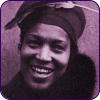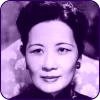Welcome to the web’s most comprehensive site of quotations by women. 43,939 quotations are searchable by topic, by author's name, or by keyword. Many of them appear in no other collection. And new ones are added continually.
Search by Topic:
Find quotations by TOPIC (coffee, love, dogs)
or search alphabetically below.
Search by Last Name:
Search by Keyword:
Fabric Arts
-
“Oh what a tangled web we weave when first we practice to weave.”
-
“What was this passion that attacked women for knitting under the most unpropitious conditions? A woman did not look her best knitting; the absorption, the glassy eyes, the restless busy fingers! One needed the agility of a wildcat, and the will power of a Napoleon to manage to knit in a crowded tube, but women managed it! If they succeeded in obtaining a seat, out came a miserable little strip of shrimp pink and click-click went the pins!”
-
“ I sewed good wishes and thoughts into my garments, especially so if they were wedding or graduation dresses.”
-
“knotted with love / the quilts sing on.”
-
“You know you knit too much when ... Before you buy anything, such as a hammock or curtains, you seriously wonder whether you could knit it.”
-
“I'm a knitter. My projects are the ultimate in 'some assembly required.'”
-
“In the nineteenth century, knitting was prescribed to women as a cure for nervousness and hysteria. Many new knitters find this sort of hard to believe because, until you get good at it, knitting seems to cause those ailments.”
-
“When you are knitting socks and sweaters and scarves, you aren't just knitting. You are assigning a value to human effort. You are holding back time. You are preserving the simple unchanging act of handwork.”
-
“There is no wrong way to knit. ... We should all agree to stop correcting each other and deal with the more important issue. How wrong crochet is.”
-
“The first time you find yourself having a conversation about moss stitch with a group of people who aren't desperately trying to escape you ... it's like coming home.”
-
“It is a little known fact that much like birds, who can always find north, knitters can always find yarn.”
-
“The chances of running out of yarn on a project are directly related to the difficulty that you will have getting more.”
-
“It is some kind of miracle that all knitting is constructed of only two stitches: knit and purl. Sure, you throw in some yarn overs, and sometimes you knit the stitches out of order, but when it really comes down to it, knitting is simplicity. The most incredible gossamer lace shawl ... the trickiest aran ... a humble sock ... each just made with knit and purl.”
-
“'Heirloom' is knitting code for 'This pattern is so difficult that you would consider death a relief.'”
-
“Some women don't care how their quilts look. They piece the squares together any sort of way, but she couldn't stand careless sewing. She wanted her quilts, and Joy's, made right. Quilts stay a long time after people are gone from this world, and witness about them for good or bad. She wanted people to see, when she was gone, that she'd never been a shiftless or don't-care woman.”
-
“What my mother teaches me are the essential lessons of the quilt: that people and actions do move in multiple directions at once.”
-
“... half-a-day's sewing would give me such a fit of depression and ennui as a week's idleness would not repair. ... I had rather wear a hair shirt than make a linen one, or alter a 'winter shawl.'”
-
“Knitting is formed by a series of loops pulled through loops to the end of time or to 'desired length'. By picking up loops and working in the opposite direction you are really picking up the concavities between the loops, and it is sheer unexpected witchcraft that stocking stitch and garter stitch will permit such an anomaly. Be grateful for this and don't expect anymore.”
-
“Remember, measure twice, cut once.”
-
“What you should understand when undertaking the construction of a quilt is that it is comprised of spare time as well as excess material.”
-
“I always tell new knitters not to make a scarf their first project. It looks like an easy way to start ... But such a project doesn't teach the knitter anything except patience ...”
-
“Any fool can make a quilt; and, after we had made a couple of dozen over twenty years ago, we quit the business with a conviction that nobody but a fool would spend so much time in cutting bits of dry goods into yet small bits and sewing them together again, just for the sake of making believe that they were busy at practical work.”
-
“Knitting is not just a metaphor. Knitting is a life.”
-
“To sew is to pray. Men don't understand this. They see the whole but they don't see the stitches. They don't see the speech of the creator in the work of the needle. We mend. We women turn things inside out and set things right. We salvage what we can of human garments and piece the rest into blankets. Sometimes our stitches stutter and slow. Only a woman's eyes can tell. Other times, the tension in the stitches might be too tight because of tears, but only we know what emotion went into the making. Only women can hear the prayer.”
-
“My focus on silence is to be understood as an intrinsic part of the body's search for meaning amongst the noisy assaults of everyday life. ... What quilts have brought to the viewing of art generally is this intervening layer of silence, of collected thought and concerted attention.”
-
“My quiltmaking is sandwiched, moved about, displaced between other activities and the crosscurrents of people's movements inside the place I live.”
-
“Our quilts were more than useful, they had the faint sentimentality of a pressed flower. And no more beauty. We did not value them for their appearance, but for the memories in them, for their good wearing qualities and the thrift they represented.”









